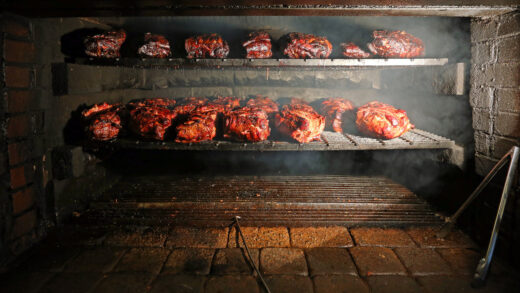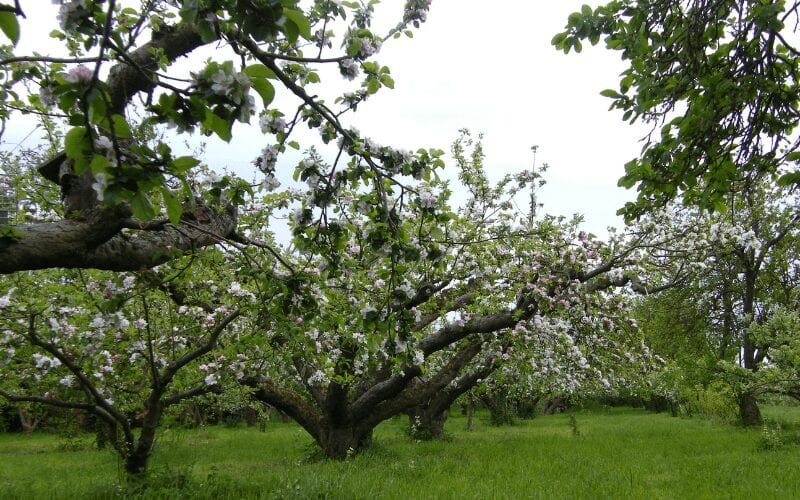
Do you have an unruly old apple tree? Are you wondering if your tree is worth saving? In many cases, you can revitalize old apple trees. And in this article, I’ll share some quick and easy fixes that will turn your old apple tree back into a great fruit producer. Rejuvenating your tree rather than removing it can offer other advantages as well, as your old apple tree can provide essential habitat and food for beneficial insects and wildlife.

WHY OVERGROWN OLD APPLE TREES ARE PROBLEMATIC
Sometimes trees get overgrown and that is ok. After all, nothing in life is perfect. However, leaving old apple trees in this neglected state can cause problems. When there are too many branches in a tree’s canopy, air cannot circulate. These damp and dark conditions will attract fruit tree pests and diseases that may damage old apple trees and turn their fruit into a maggoty mess.
On top of all that, these pests and diseases can then spread to neighbouring fruit trees.
The tangle of branches may also block the sun from reaching other branches. So, if your old apple tree does still produce fruit, the fruit that is hidden in the dense canopy will not have access to the sunshine it needs to ripen properly. The result will be poor-tasting fruit and an unattractive tree.
On that note, one of the most important things you can do to improve the health of an old apple tree is to prune it correctly. In an episode 61 of The Urban Forestry Radio Show and Podcast, fruit tree pruning expert Bob Lever explains some of his strategies for pruning old apple trees.
You can watch a 10-minute long video excerpt of Bob Lever’s interview below.
As you can see from Bob Lever’s video, pruning old apple trees does not have to be difficult. Here are five options to consider when pruning old apple trees. I call it the “RIPSS” technique!
HOW TO PRUNE OLD APPLE TREES
- Remove dead, damaged, and diseased branches
- Improve air circulation by removing scaffold branches
- Prune sail branches
- Snip water sprouts
- Shorten scaffold branches
Let’s delve into these options, one at a time:
OPTION 1: Remove dead, damaged and diseased branches
The first step in pruning an old apple tree – or any tree at all – is to remove the dead, damaged or diseased branches. Dead branches won’t have living buds, blossoms or leaves. They may have died of natural causes or as a result of disease. Damaged branches may be broken or may have a wound on them. Both dead and diseased branches provide an entry point for pest and disease problems. Finally, diseased branches may have strange growths on them that don’t belong there, or they may be releasing oozing goop. If you don’t remove diseased branches, these problems can easily spread.
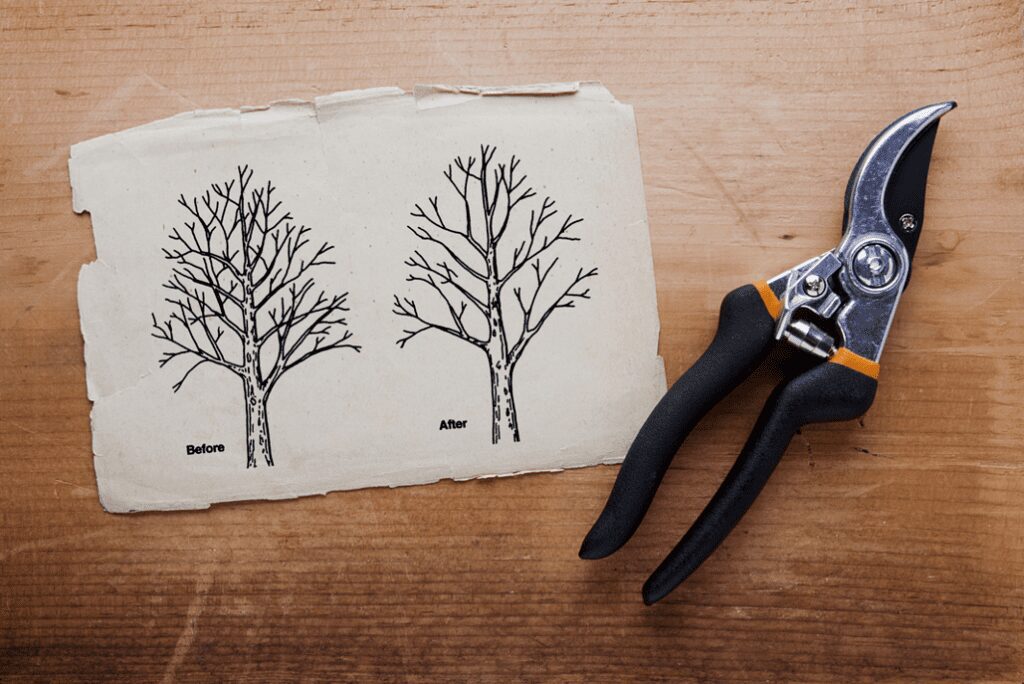
OPTION 2: Improve Air Circulation by Removing Scaffold Branches
Good air circulation is an important way to prevent fruit tree pests and diseases. You can improve air circulation in your old apple tree by removing some scaffold branches. These are the large branches that come off the trunk of the tree. These branches can be quite large, so if you just remove one of them, you can easily allow light and air into the canopy. Your goal is to be able to throw a football through the tree’s branches. Instead of getting caught in a tangle of branches, it should fall through to the ground. So, look for branches that are clumped together and remove some of those scaffold branches.

OPTION 3: Prune Sail Branches
Some old apple trees are so large that their scaffold or side branches sprout new trees on them! Sail branches look like an entire new tree that is growing off one of the established scaffold branches. Sail branches can be dangerous as they put pressure on the old apple tree and create instability through the branch and tree and so they need to be removed.

OPTION 4: Remove Water Sprouts
Removing water sprouts is another option. Water sprouts (epicormic growth) are leafy branches that grow out of scaffold branches and reach straight up towards the sky. Water sprouts often form after a grower over-prunes their old apple tree.
When they first form, these non-fruiting sprouts help the tree survive and capture energy from the sun. But over the years, after the tree recovers, they drain energy from the tree. By removing them, that energy will be diverted to the fruiting branches of the tree.
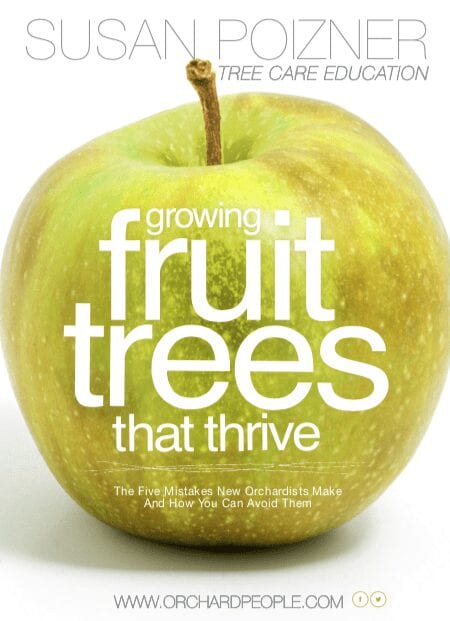
Fruit Tree Care Newsletter
Sign up for our monthly newsletter and we will send you our eBook “Growing Fruit Trees That Thrive.” You can unsubscribe at any time.
The only time you may want to keep some water sprouts is when a tree is very old, hollow and doesn’t have any scaffold branches left. In those cases, the epicormic growth can help keep the tree alive.

OPTION 5: Shortening Scaffold Branches
Finally, in some cases you may need to shorten scaffold branches. Old apple trees often have scaffold branches that get longer and longer each year. And these long branches become heavy and unstable. By shortening scaffold branches you will be preventing these branches from breaking in the future. If they do break, they will open up a wound in the tree which is never a good thing.
In the video below, expert fruit tree pruner Bob Lever from the UK will share his tips on pruning old apple trees.
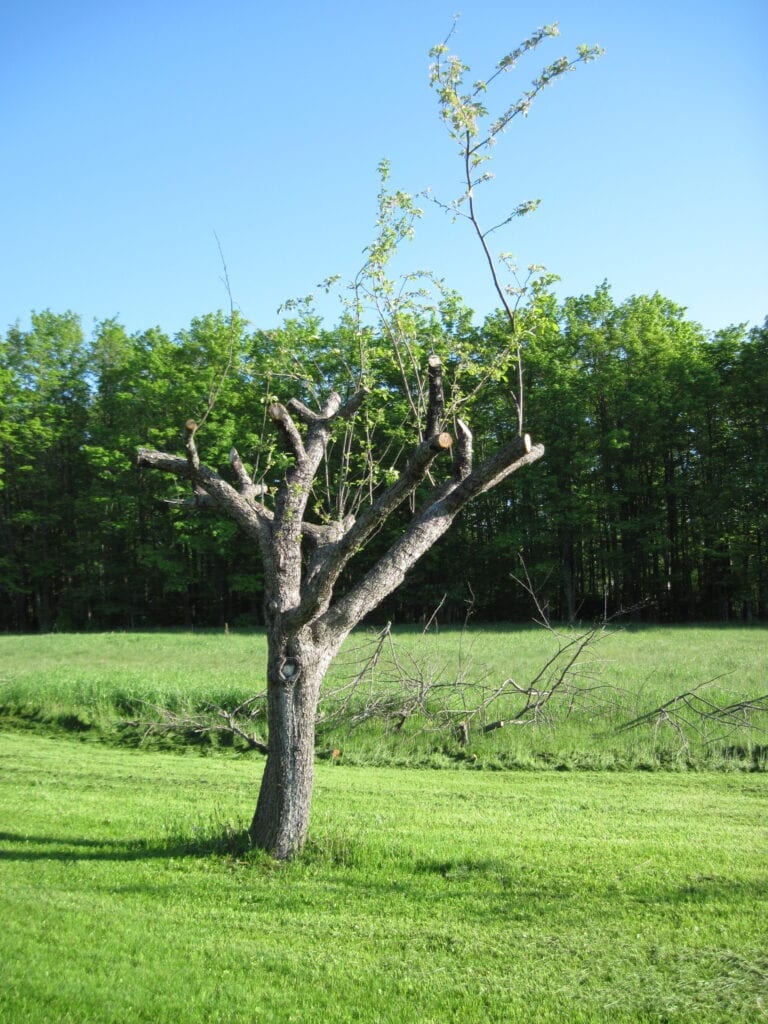
HOW MUCH OF A TREE CAN YOU PRUNE WITHOUT KILLING IT?
In short, yes, over-pruning can kill an old apple tree. Branches provide nutrients for the tree and when you remove too many branches it can cause a shortage of nutrients and stress your old apple tree. So often, you cannot accomplish all the RIPSS options above in a single year.
And as we learned above, your tree will respond to over-pruning by growing back even more vigorously, creating more water sprouts and more of a mess. A good rule of thumb is to limit pruning to 20% or less of the canopy each year. This means that in four years, a neglected old apple tree can be transformed into a healthy and productive fruit tree.
WHEN IS THE BEST TIME TO PRUNE OLD APPLE TREES?
Timing is important when pruning an old apple tree. Winter pruning can be beneficial because there are no leaves on the branches, and you can clearly see the tree’s structure. A downside to winter pruning is that it often leads to vigorous growth. And that will make your old apple tree’s problem worse!
Sometimes it is better to prune during the early summer when the tree doesn’t have much energy to bounce back and grow even more. Before you decide when to prune your old apple tree, read more about when to prune fruit trees here.
how to prune an apple tree correctly ?
Well, it is all fine and dandy to know what branches to cut on old apple trees. And it’s great to know how much of your tree you can remove each year (20% of the living canopy or less!). And it’s amazing to be able to make a knowledgeable decision on when to prune your fruit tree.
But it is essential to know how to make your cuts safely and effectively without damaging your tree, your property, or yourself! There are two main cuts when it comes to pruning – thinning out and heading back.

Thinning out cut
The thinning out cut is used to remove a branch completely. This is primarily used to increase air circulation in the canopy. In this technique, you will choose entire branches and remove them close to the trunk. Branches that emerge from the trunk are called scaffold branches.
But if you do this cut incorrectly, you may actually damage your tree!
So you must be careful to remove the branch right up to its “collar” without removing the collar. The collar looks a bit like a turtleneck or a ring that is right around the base of the branch. The collar is necessary as it has cells that allows the branch to eventually heal the pruning cut. So, when you remove the branch, be sure to leave the collar behind!

Smaller branches can be removed with hand tools like a hand-pruner or a lopper. But larger branches may need to be removed with the help of a hand saw. On a thicker branch you’ll need to do a three-step cut to prevent the falling branch from ripping the bark at the side of the tree.
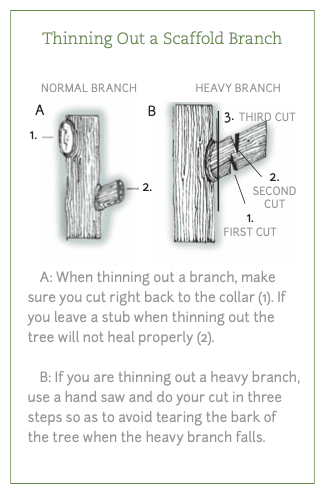
This image from Susan Poizner’s award-winning fruit tree care book Growing Urban Orchards shows you how.
First make a cut on the bottom of the branch. Cut upwards into the branch to about halfway through the branch. The second cut is on the top of the branch and a further away from the trunk. Now you can make your final downward cut. With this branch now removed, the branch collar will eventually grow over the wound. This will help prevent pests and diseases from finding their way into your old apple tree.

Heading back cut
The heading back cut is used to shorten branches. To shorten a scaffold branch first determine the length it should be cut to. Keep in mind that you want your branch to be strong and stable. With that length in mind, make your cut just past a healthy bud and voila – you have a heading back cut!
Maintaining your fruit tree pruning tools
When you’re pruning your old apple trees, you need to make sure that your tools are clean and sharp. Listen to this podcast (or watch the video) to learn more!
And if you need to buy excellent fruit tree pruning tools, check out the tools that we recommend in our online store.
WHY SAVE OLD APPLE TREES?
Once you start pruning your old apple tree, you will see that the quality of the fruit will improve. That’s because the tree will not have to support as many branches and instead it can use that energy into improving fruit quality.

Also, if you can save an old apple tree and improve its health, you can begin to graft different varieties of fruit on branches! You may just have a Mcintosh apple tree, but with grafting you can get your tree to produce Gala, Honeycrisp or one of the many heirloom and other apple varieties. You can explore different apple varieties in this article. Then, learn more about grafting in this article.
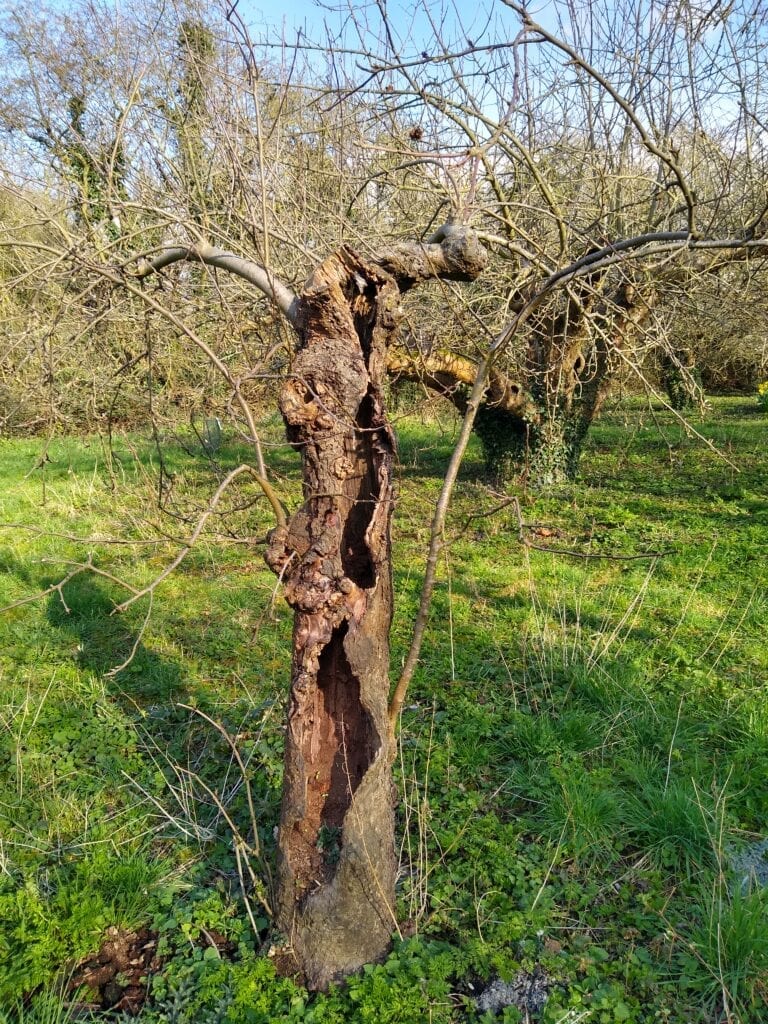
Another reason to prune old apple trees is for the environment. Healthy old apple trees bloom with flowers that contain nectar and pollen that species like bees and birds can feed on. Old apple trees can also become homes for critters like birds that nest in the hollow trunks.
You can learn more about pruning old apple trees by listening to this episode of The Urban Forestry Radio Show and Podcast with Bob Lever.
HOW TO PRUNE APPLE TREES AND OTHER FRUIT TREES
This article explores how you prune old apple trees. But if you have a younger fruit tree, your approach will be very different! You can learn how to prune, feed, and protect fruit trees of all ages from pests and diseases in OrchardPeople.com’s premium courses on fruit tree care.
Enjoy your old apple tree!
Q&A ABOUT HOW TO PRUNE OLD APPLE TREES
Q: Should You Hard Prune an Overgrown Apple Tree?
A: Hard pruning an overgrown apple tree is not a good idea as it can stress the tree and lead to vigorous water sprout development. Instead, prune no more than 20% of the tree each year. This gradual approach prevents the tree from becoming stressed and encourages healthier growth.
Q: What Is the Best Month to Prune Apple Trees?
A: The best time to prune apple trees is during the winter when the tree is dormant, or in early summer. Winter pruning helps you see the tree’s structure clearly, but it can stimulate vigorous growth. Early summer pruning limits this response, making it a good choice for overly vigorous trees.
Q: What Is the Lifespan of an Apple Tree?
A: The lifespan of an apple tree varies, but many can live for several decades. Old apple trees on full sized root stocks can live for over a century! Proper care, including regular pruning and maintenance, can significantly extend the life of an apple tree.
Q: Should You Cut the Top Off an Apple Tree?
A: Absolutely not! Cutting the top off an apple tree, known as “topping” can harm the tree and lead to weak, fast-growing water sprouts. Instead, focus on selective pruning to maintain the tree’s natural shape and health.
Q: What Are Three Types of Branches to Prune Out When Pruning Mature Apple Trees?
A: When pruning mature apple trees, focus on removing dead, diseased, or damaged branches, water sprouts, and any branches that cross or rub against each other. This helps improve the tree’s overall health and fruit production. Once you have done that, you can then start pruning to develop a better structure for the tree using the instructions in this article.
Q: Can You Prune Apple Trees All Year Round?
A: It’s best to avoid pruning apple trees during the autumn, as new growth might not harden off before winter. Winter and early summer are the ideal times for pruning, depending on your goals and the tree’s condition.
Q: When Can You Cut Dead Branches Off an Apple Tree?
A: You can remove dead branches from an apple tree at any time of the year. Removing them as soon as you notice them helps prevent disease and pests from invading the tree.

The author of this article is Loretta Higgins, an intern at OrchardPeople.com. She is a student at the University of Guelph and her passions include sustainable living on her family farm and athletics of all kinds.
#Prune #Apple #Trees #Produce #Fruit



